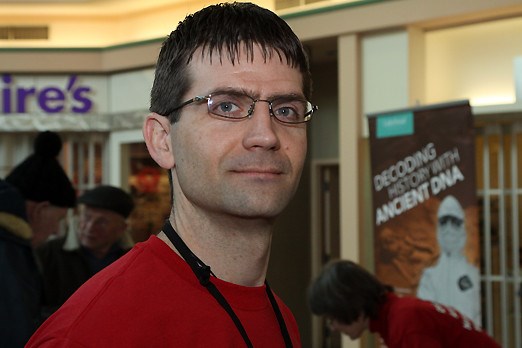It may take a couple of weeks and cost $50 but residents say it means so much more to get their DNA tested and learn more about their family ancestry.
Lakehead University kicked off its sixth annual Research and Innovation week at Intercity Shopping Centre on Saturday. Early shoppers and mall walkers looked at the nine exhibits that were on display throughout the shopping centre.
A popular favourite was the deep ancestry DNA testing. For $50, residents lined up for a maternal or paternal test that either looked at the mother or father strain of DNA. To get the sample, participants took a cue tip to the inside of the mouth. The results for the tests take normally six to eight weeks because of the large volume of participants.
Alyson Kailik, 35, said she was adopted and wanted to know more about her biological family. She learned who her grandmother was and hoped the DNA test would reveal more about her grandfather as well as offer some clues on where she came from.
"I want to learn a little bit about my heritage," Kailik said. "When you’re adopted you really don’t know anything about your family, you don’t know a lot about your medical information, so even a little glimmer of (information) could be become important."
Seppo Natri, 63, immigrated to Canada from Finland in 1978 and moved to Thunder Bay in 1981. He said he has enjoyed living in Canada but wanted to know more about his family past. Around the time of the Second World War, Finland lost a portion of Karelia to the then Russian Soviet Union. He said he wanted to know if he had any family roots in Karelia.
"When you are getting a little bit older family heritage becomes much more important," Natri said. "It’s pretty interesting to see where I came from."
Stephen Fratpietro, technical manager of Lakehead University Paleo DNA laboratory, said the exhibit has been popular since it started three years ago. The first year the exhibit offered the test about 25 people were tested but that number has since grown with more than 200 tested last year.
He said the test could go far back as far as 10,000 years and show where that family member came from. The lab takes the information from the test, creates a profile of the individual, places the information in separate categories called haplo groups and from there, technicians can map out the ancestry line, he said.
"This is just general information," Fratpietro said. "As a population moves from one area to another and stays there for 10,000 years it has its own DNA profile. When it moves to another area, the DNA changes and it becomes a different haplo groups."
The exhibit will be up until the mall closed at about 6:30 p.m., he added
Sign in or register
- Messages
- Post a Listing
- Your Listings
- Your Profile
- Your Subscriptions
- Your Likes
- Your Business
- Support Local News
- Payment History
Registered Users
Already have an account?
New Users
Create a free account.
